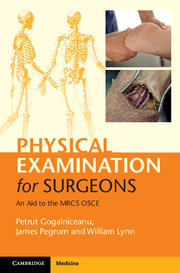Book contents
- Frontmatter
- Dedication
- Contents
- List of contributors
- Introduction
- Acknowledgments
- List of abbreviations
- Section 1 Principles of surgery
- Section 2 General surgery
- 3 Examination of peripheral stigmata of disease in general surgery
- 4 Examination of the abdomen
- 5 Examination of abdominal scars
- 6 Examination of the groin
- 7 Examination of a stoma
- 8 Renal access and transplant examination
- Section 3 Breast surgery
- Section 4 Pelvis and perineum
- Section 5 Orthopaedic surgery
- Section 6 Vascular surgery
- Section 7 Heart and thorax
- Section 8 Head and neck surgery
- Section 9 Neurosurgery
- Section 10 Plastic surgery
- Section 11 Surgical radiology
- Section 12 Airway, trauma and critical care
- Index
7 - Examination of a stoma
from Section 2 - General surgery
Published online by Cambridge University Press: 05 July 2015
- Frontmatter
- Dedication
- Contents
- List of contributors
- Introduction
- Acknowledgments
- List of abbreviations
- Section 1 Principles of surgery
- Section 2 General surgery
- 3 Examination of peripheral stigmata of disease in general surgery
- 4 Examination of the abdomen
- 5 Examination of abdominal scars
- 6 Examination of the groin
- 7 Examination of a stoma
- 8 Renal access and transplant examination
- Section 3 Breast surgery
- Section 4 Pelvis and perineum
- Section 5 Orthopaedic surgery
- Section 6 Vascular surgery
- Section 7 Heart and thorax
- Section 8 Head and neck surgery
- Section 9 Neurosurgery
- Section 10 Plastic surgery
- Section 11 Surgical radiology
- Section 12 Airway, trauma and critical care
- Index
Summary
Checklist
WIPER
Physiological parameters
Inspection
Scars:
• Midline laparotomy
• Laparoscopic scars
• No scars and stoma: trephine colostomy
• Linear or purse-string scar in RIF or LIF: reversed stoma
Stoma character:
• Site: RIF vs. LIF
• Spouted vs. flush
• Size of lumen
• Number of lumens
• Stoma bridge
• Bag contents:
•urine (urostomy)
•small bowel contents: liquid (ileostomy)
•formed faeces (colostomy)
Stoma complications:
• Parastomal mass (hernia)
• Dusky or ischaemic mucosa
• Surrounding skin excoriated
• Stoma edge dehiscence
• Stoma retraction
Palpation
• Palpate around stoma and ask patient to cough to exclude parastomal hernia.
• Digitate stoma with a well-lubricated finger (only if required).
Percussion
• Hyper-resonance: bowel obstruction
Auscultation
• Hyperactive bowel sounds in bowel obstruction
• Quiet bowel sounds in ileus
To complete the examination…
• Ask to examine the perineum to determine if the anal orifice is present.
• Perform a full examination of the abdomen.
Examination notes
What is the definition of a stoma?
A stoma is a surgically created communication between a hollow viscus and the skin.
What are the different types of stomas?
• Ileostomy – ileum
• Colostomy – colon
• Urostomy – ileum anastomosed to ureters
How are stomas constructed?
• End-stoma: single lumen. Suggests that the distal end of the viscus has either been resected or closed and left in the abdomen; e.g. Hartmann's procedure.
• Loop-ileostomy: two lumens may be seen. The distal end of the viscus is present but defunctioned, e.g. to allow an anastomosis to heal.
• A urostomy is formed when the urinary bladder has been excised. A loop of ileum (ileal conduit) is separated proximally and distally. The ureters are anastomosed to one end, and the other end is used to form the stoma (urostomy).
- Type
- Chapter
- Information
- Physical Examination for SurgeonsAn Aid to the MRCS OSCE, pp. 80 - 83Publisher: Cambridge University PressPrint publication year: 2015



